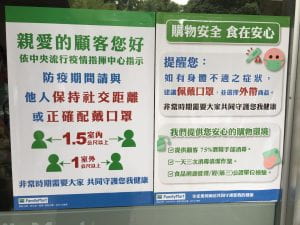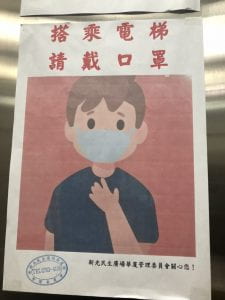7 April 2020
Were it not for COVID-19, I would be in the United States right now. As a visiting scholar at the University of California, San Diego, I would be building my own daily routines—alone, by myself—in a foreign city. I have been expecting and preparing for this three-month scholarly exchange for almost half a year, yearning to be away from my hometown, from everything and everyone that is so familiar to me that it almost makes me feel confined—until this 0.1-micrometer virus obstructed the flight of the 6300-meter Boeing 787 that I was supposed to be on.


So here I am, in my hometown Taipei, reflecting on the virus. Living in a country in which a “stay-at-home” order is not enforced, everything seems as usual: people go to work or school, stores are open with normal business hours, and public transportation continues to function. But there is something unusual growing within society. Nearly every building has only one door operational, so that a security guard can measure body temperatures and spray sanitizer on the hands of anyone who wishes to enter. If you take public transportation, you are required to wear a mask. Those who don’t comply will be fined. Universities decline entry without a proper ID. There are signs everywhere reminding people to maintain a social distance of “1.5 meters indoors, 1 meter outdoors.” Official instructions on how to wash hands, and how to sanitize masks and make them reusable with a “電鍋” (dian guo), the standard Taiwanese electric rice cooker that every family owns, bombard everyone.
A rearranged human-object relation is being formed. A newly disciplined body performance is being practiced. A new social order is being established. This is how humans live with the virus, the disaster caused by humans themselves. The reality of the disaster that we have to live with reminds me of the novel The Man with the Compound Eyes《複眼人》by Taiwanese writer Wu Ming-Yi (吳明益), which tells the story of a trash vortex crashing into the eastern coast of Taiwan, leading to severe ecological detriment and turning Taiwan into a land full of waste. What strikes me most is that the disaster depicted in the novel is not an apocalyptic end of time and beings; instead, the disaster is a juncture which compels people to recognize their own precarious circumstances as well as those of nature. And that is exactly what the virus prompts us to do.
My studies concern how, ecologically and technologically, literary works lead us to contemplate the situation we are dealing with, so I find that the present state we live in reveals just how much reality meets fiction: the waste that drifts to the island in the novel is just like the presence of the virus in our daily lives. In the novel, there is no way to thoroughly get rid of the garbage that has accumulated over several decades. The novel depicts how, once people clean out an amount of waste, the waves bring another pile of waste to the coast. The same applies to the current situation. For the past two months, we have gone through two waves of high-risk infection: first, people coming back to Taiwan from China and other Asian countries; second, people coming back from Europe and the United States. Now we are undergoing the third wave. We had a four-day vacation last week (April 2-5), during which people flooded to tourist spots around Taiwan. Since it will probably give rise to cluster infections, the Taiwan Centers for Disease Control has announced that those who traveled to crowded tourist spots during the long weekend are advised to work from home, keep track of body temperature, and wear masks when not staying at home for the following fourteen days.
Everyday, we get updated infection numbers. The graphical curves of the statistics of infection look like fictional waves in the sea, bringing us piles of viruses and waste, one after another, again and again. We cannot wipe out the virus entirely, just like the waste on the land cannot be fully removed. The only thing we can do is control the damage and change our ways of living.
In The Man with the Compound Eyes, the story ends with the characters still reconstructing their lives after the disaster. The recovery of environmental and economical destruction is so long-lasting that it seems as if it will never come to an end. The narrative of disaster in this novel focuses not on dramatically disastrous scenes seen in works such as the American sci-fi disaster film The Day after Tomorrow (2014), but instead on the dispassionate description of the persistent, sometimes even mundane reconstruction of daily lives.
We now reconstruct our daily lives with masks, frequent hand-washing, social distancing, and working from home. Fiction always comes to an end whereas our real post-disaster life has just begun.
Hsin-Hui Lin is a Ph.D. student at the National Chengchi University Graduate Institute of Taiwanese Literature. Her research concerns the relationship between literary texts and ecological and technological humanities. Hsin-Hui’s MA thesis The Cyborg Reading of Contemporary Taiwanese Literature received the 2017 Annual MA Thesis Award of the National Museum of Taiwanese Literature. She once worked as editor at Unitas Literary, one of the major literary magazines in Taiwan. As a fiction writer, she has won several literary awards in Taiwan for her short stories. Her short story collection Human Glitches《瑕疵人型》is forthcoming in Chinese in June 2020.
Related:
Diary Project Taipei [2] :: Hsin-Hui Lin (Taiwan)
Diary Project Taipei [3] :: Hsin-Hui Lin (Taiwan)
Diary Project Taipei [4] :: Hsin-Hui Lin (Taiwan)
* * *
The Teach311 + COVID-19 Collective began in 2011 as a joint project of the Forum for the History of Science in Asia and the Society for the History of Technology Asia Network and is currently expanded in collaboration with the Max Planck Institute for the History of Science(Artifacts, Action, Knowledge) and Nanyang Technological University-Singapore.
![[Teach311 + COVID-19] Collective](https://blogs.ntu.edu.sg/teach311/files/2020/04/Banner.jpg)